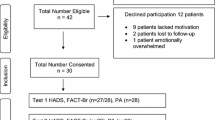Abstract
Purpose. Although a number of tools have been developed to measure ‘quality of life’ in patients with malignant glioma, there remains no completely satisfactory technique that incorporates a quality of life measure into survival analysis. We propose that a patient's ability to maintain independent activity offers a way to accomplish this goal.
Patients and methods. An independent living score (ILS) is generated by awarding points on a monthly basis based on Karnofsky score and weighing the score based on the particular month of the clinical course. The ILS has a large range for any given survival, and can discriminate important treatment effects to which standard survival analyses are completely insensitive. Using this score and several variations, we were able to retrospectively analyze a patient cohort to assess what correlated with ILS.
Results. We found a strong correlation with survival of all the measures tested. Interestingly, we found that patients for whom a total resection was performed and those who were most intensively treated had significantly higher ILS values, suggesting that not only did more aggressive treatment improve survival but that it did not simply increase survival at the expense of the time a patient remained independent.
Conclusion. Since the general course for patients with malignant glioma is one of increasing disability and loss of independence, we feel that these measures can serve as a way to distinguish between those therapies that increase survival at the expense of quality of life versus those that do not. Consideration should be given to incorporating these measures into prospective trials.
Similar content being viewed by others
References
Donovan K, Samson-Fisher RW, Redman S: Measuring quality of life of cancer patients. J Clin Oncol 7: 959–968, 1989
Mackworth N, Fobair P, Prados MD: Quality of life selfreports from 200 brain tumor patients: comparison with Karnofsky performance scores. J Neuro-Oncol 14: 243–252, 1992
Brazil L, Thomas R, Laing R, Hines F, Guerrero D, Ashley S, Brada M: Verbally administered Barthel Index as functional assessment in brain tumour patients. J Neuro-Oncol 34: 187–192, 1997
Giovagnoli AR, Tamburini M, Boiardi A: Quality of life in brain tumor patients. J Neuro-Oncol 30: 71–80, 1996
Scott CB: Quality-adjusted survival analysis of malignant glioma patients. Controlled Clin Trials 18: 277–285, 1997
Cole BF, Glantz MJ, Jaeckle K, Chamberlain M: Qualityadjusted time without symptoms and toxicity (Q-TWiST) comparison of sustained release cytarabine (DepoCyt) vs. methotrexate treatment for patients with carcinomatous meningitis. Proc ASCO 17: 405a, 1998
Sachsenheimer W, Piotrowski W, Bimmler T: Quality of life in patients with intracranial tumors on the basis of Karnofsky's performance status. J Neuro-Oncol 13: 177–181, 1992
Hochberg FH, Linggood R, Wolfson L, Baker WH, Kornblith P: Quality and duration of survival in glioblastoma multiforme. JAMA 241: 1016–1018, 1979
Mor V, Laliberte L, Morris JN, Wiemann M: The Karnofsky performance scale. An examination of its reliability and validity in a research setting. Cancer 53: 2002–2007, 1984
Glantz MJ, Choy H, Kearns C, Cole BF, Mills P, Zuhkowski E, Saris S, Rhodes CH, Stopa E, Egorin M: Aphase I study of weekly, out-patient paclitaxel and concurrent cranial irradiation in adults with astrocytomas. J Clin Oncol 14: 600–609, 1996
Glantz MJ, Choy H, Akerley W, Kearns CM, Egorin MJ, Rhodes CH, Cole BH: Weekly paclitaxel with and without concurrent radiation therapy: toxicity, pharmacokinetics, and response. Sem Oncol 6 (Suppl. 16): 128–135, 1996
Fries JF: Aging, natural death, and the compression of morbidity. New Engl J Med 303: 130–135, 1980
Karnofsky DA, Burchmal JH: The clinical evaluation of chemotherapeutic agents in cancer. In: MacLeod CM (ed.) Evaluation of Chemotherapeutic Agents. Columbia Univ Press, 1949, pp 191–205
Whitton AC, Rhydderch H, Furlong W, Feeny D, Barr RD: Self-reported comprehensive health status of adult brain tumor patients using the health utilities index. Cancer 80: 258–265, 1997
Nazzaro JM, Neuwelt EA: The role of surgery in the management of supratentorial intermediate and high-grade astrocytomas in adults. J Neurosurg 73: 331–344, 1990
Kowalczuk A, Macdonald RL, Amidei C, Dohrmann G, Erickson RK, Hekmatpanah J, Krauss S, Krishnasamy S, Masters G, Mullan SF, et al.: Quantitative imaging study of extent of surgical resection and prognosis of malignant astrocytomas. Neurosurgery 41(5): l028–1038, 1997
Kreth FW, Berlis A, Spiropoulou V, Faist M, Scheremet R, Rossner R, Volk B, Ostertag CB: The role of tumor resection in the treatment of glioblastoma multiforme in adults. Cancer 86: 2117–2123, 1999
Author information
Authors and Affiliations
Rights and permissions
About this article
Cite this article
Recht, L., Glantz, M., Chamberlain, M. et al. Quantitative Measurement of Quality Outcome in Malignant Glioma Patients Using an Independent Living Score (ILS). J Neurooncol 61, 127–136 (2003). https://doi.org/10.1023/A:1022187502917
Issue Date:
DOI: https://doi.org/10.1023/A:1022187502917




